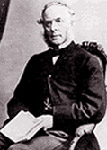
|
Robert Fortune
(1812-1880) was a Scotsman who is said to have introduced over
120 new types of plants to the West. As soon as word reached England that
the Opium War was over, Fortune obtained appointment as Botanical Collector
to the Horticultural Society of London. After a four month passage
from England, he arrived in China where he remained from July 1843 to December
1845. While there he dressed in local costume and had a shaved head
in order to travel inland beyond treaty allowances. He met with fever,
robbers, pirates, and storms during his travels and collecting on the mainland
and neighboring islands.
Fortune sent several shipments of seeds and live plants in Wardian cases back to the Society's garden at Chiswick, where he had been superintendent of the hothouses. By the time he returned to England some of his earlier specimens already had been propagated and transferred to other principal gardens in Europe. During his first China stay he also spent two months in Manila and the Philippines. He was also in China from August 1848 (after a two month passage) until 1851. From this visit he introduced thousands of tea plants into northwestern India that March. These experiments founded [sic] the tea industry there, possibly to allow the British to be able to control the tea in a friendlier area than China. Fortune returned to China in March of 1853 (until 1856), and then on again to India, from February to November of 1856, with many seeds and plants of ornamental trees and shrubs likely to be of value there. In 1858 he was employed by the American government to explore China for tea plants which would grow in the Southern States. And then, for a short time, he was once more in China, by way of Japan, in July of 1861. He left Europe in the summer of 1860 and reached Nagasaki before mid-October. After one week of touring the countryside and visiting nurseries, he set off for the area of Yokohama and Edo (the old name for Tokyo which Fortune calls Yedo). He arrived in the former after a fortnight, where he spent the same period before crossing to the capital. Mid-December he set steam for the Inland Sea, then back to collecting in Nagasaki briefly before crossing to Shanghai on January 2nd. Fortune was back in Japan by mid-April near the Bay of Shimoda. During the next three months he visited the region between Kamakura and Edo before departing the capital, again sailing to Shanghai. Robert Fortune's travel books were enormously popular, went through several editions, and made him the most famous British traveler in the China of his time. (His phenomenal success must have inspired many young men to follow in his footsteps, although he was perhaps the last to make most of his valuable discoveries in the gardens and nurseries in the cities.) His humor, entertaining anecdotes, and vivid descriptions certainly helped sell books. But the very fact that the site of his travels was China must have also been a central attraction. To the British public, China remained very much the ultimate Other, the antipode to Europe. 1 |

|
A Journey to the Tea Countries of China
(1852):
"...On visiting some of the flower-shops
in Shanghae, in the middle of January, I was surprised to find a great
many flowers which had been forced into bloom and were now exposed for
sale. I was not previously aware that the practice of forcing flowers
was common in China....
"A few days after visiting the moutan
(tree peony) district, I went to see the azalea gardens, which were equally
interesting. About five miles from the city there are two nurseries,
each of which contains an extensive and valuable collection. They
are usually known as the Pou-shan Gardens, and are often visited by the
foreign residents in Shanghae... In the front of the [residence of
the nurseryman] three or four flat stages were covered with Japanese plants,
of which the old man had a good collection. A small species of pinus
was much prized, and, when dwarfed in the manner of the Chinese, fetched
a very high price; it is generally grafted on a variety of the stone pine.
|
|
A Residence Among the Chinese
(1857):
" [The less known Howqua's Garden] is situated near the well-known Fa-tee nurseries, a few miles above the city of Canton, and is a place of favourite resort both for Chinese and foreigners who reside in the neighbourhood, or who visit this part of the Celestial Empire... The plants consist of good specimens of southern Chinese things, all well known in England, such, for example, as Cybidium sinense, Olea fragrans, oranges, roses, camellias, magnolias, &c., and, of course, a multitude of dwarf trees, without which no Chinese garden would be considered complete."
"I have already noticed a new cedar or
larch-tree named
Abies Kaempferi
discovered amongst these mountains
[near the city of Ningbo]
. I had been acquainted with this interesting
tree for several years in China, but only in gardens, and as a pot plant
in a dwarfed state. The Chinese, by their favourite system of dwarfing,
contrive to make it, when only a foot and a half or two feet high, have
all the characters of an aged cedar of Lebanon. It is called by them the
Kin-le-sung, or Golden Pine, probably from the rich yellow appearance
which the ripened leaves and cones assume in the autumn."
4
|